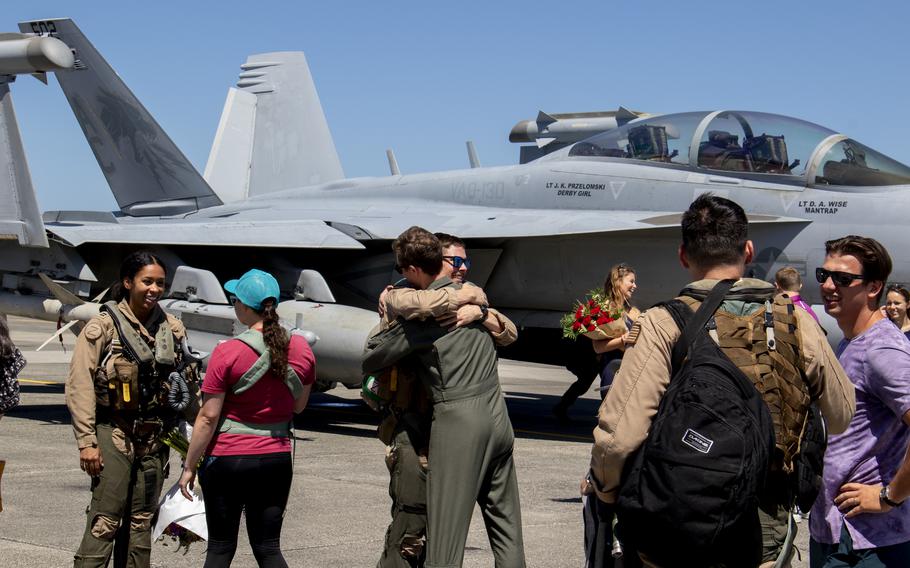
Pilots assigned to the Electronic Attack Squadron 130 are greeted by friends, family and service members upon their return home to Naval Air Station Whidbey Island, Wash., July 13, 2024. (William Sykes/U.S. Navy)
Electronic Attack Squadron 130 made the long flight home to the West Coast over the weekend and the aviators returned to their families after their combat deployment in the Red Sea, where it joined the fight against Iran-backed Houthi rebels.
The squadron was one several returning from the nine-month deployment in the Middle East with the USS Dwight D. Eisenhower. The other squadrons that lifted off the aircraft carrier near the port in Norfolk, Va., only had to fly their F/A-18 Hornet jets to Naval Air Station Oceana in Virginia Beach for a welcome-home reception.
But the squadron of EA-18G Growlers known as the “Zappers” is stationed at Whidbey Island Naval Air Station, Wash., which is northwest of Seattle. It’s the center for the Navy’s carrier-based electronic warfare squadrons.
“I can’t remember the last time the Navy had a more challenging deployment with a combination of multiple extensions, severely limited opportunities for [rest and relaxation], and true combat,” said Cmdr. Carl Ellsworth, the squadron commander. “Not just for aviators, but the crew of the whole strike group as well, in the most kinetic action at sea since World War II.”
It was another 2,500 miles before the squadron received a homecoming Saturday from family, friends and other Whidbey Island aviators and crew who came out to greet the returning Zappers.
The Growlers’ job was to find the missile and drone launch points of the Houthis to prevent attacks on commercial and naval ships in the Red Sea. The aircraft went after radar installations that are the eyes of the enemy units.
The squadron was the first to employ an Advanced Anti-Radiation Guided Missile in combat.
“During the historic combat deployment aboard the USS Dwight D. Eisenhower, the Zappers executed continuous combat operations in the southern Red Sea, Bab al-Mandeb Strait, and Gulf of Aden,” the Navy said in a statement. “Their goal was to take out Houthi launch sites and, if already in the air, the Houthi weapons before they could hit U.S. or commercial shipping in international waterways.”
The E/A-18G Growler — a variant on the F/A-18E Super Hornet — is the U.S. military’s only dedicated electronic attack aircraft. Its primary role is “suppression of enemy air defenses.”
The squadron conducted strikes into Houthi-controlled Yemen under Operation Yukon Lightning, which the Navy said degraded the Houthi’s capability to threaten shipping lanes. The squadron also supported the launch of more than 120 standard missiles and dozens of Tomahawk missiles by U.S. and coalition ships, aircraft and other assets.